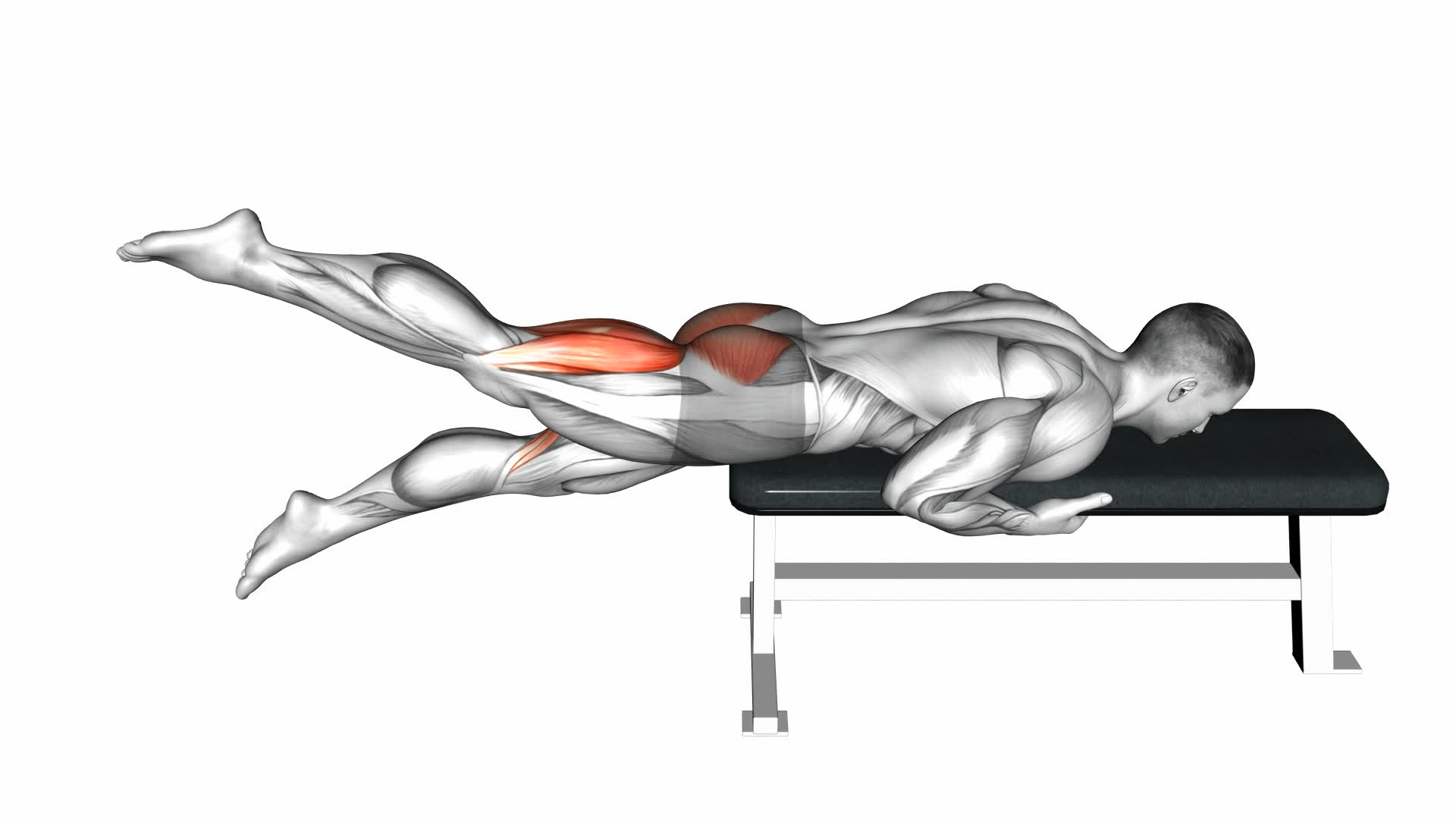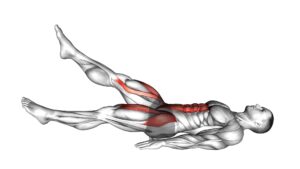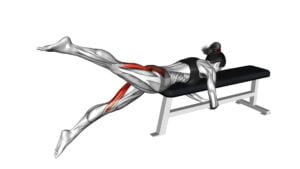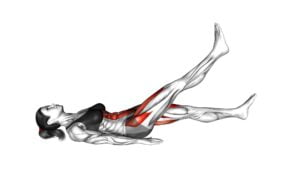Flutter Kicks (version 2) – Video Exercise Guide & Tips

Get ready to take your fitness routine to the next level with Flutter Kicks (version 2).
Watch This Exercise Video
In this video exercise guide, we'll show you the proper form and technique to maximize the benefits of this challenging exercise.
Whether you're a beginner or a seasoned fitness enthusiast, we've got tips to help you avoid common mistakes and increase intensity.
So grab your mat and get ready to feel the burn with Flutter Kicks (version 2)!
Key Takeaways
- Flutter kicks (version 2) strengthen abdominal muscles.
- They target lower abs, obliques, and hip flexors.
- Flutter kicks engage multiple muscle groups simultaneously.
- They work glutes, quads, and hamstrings and improve overall muscle tone.
Benefits of Flutter Kicks (version 2)
One of the benefits of Flutter Kicks (version 2) is their ability to strengthen your abdominal muscles. Flutter kicks, also known as scissor kicks, are a versatile exercise that offers various variations to keep your workout routine interesting and challenging. By incorporating different variations of flutter kicks into your routine, you can target different areas of your core, including your lower abs, obliques, and hip flexors.
Incorporating flutter kicks into a full body workout is an effective way to engage multiple muscle groups simultaneously. They not only work your abs but also engage your glutes, quads, and hamstrings. This makes flutter kicks a great addition to any full body workout routine, helping you build strength and improve overall muscle tone.
Proper form for flutter kicks (version 2) is crucial to achieving optimal results and avoiding injury. It's important to lie flat on your back with your legs straight and your hands placed comfortably under your glutes for support. Keep your core engaged and lift your legs a few inches off the ground, alternating between raising one leg up while lowering the other. Remember to keep your movements controlled and maintain a steady pace throughout the exercise.
Proper Form for Flutter Kicks (version 2)
To perform flutter kicks (version 2) with proper form, follow these steps:
- Lie on your back and place your hands comfortably under your glutes for support.
- Keep your legs straight and together, and lift them about six inches off the ground.
- Engage your core by pressing your lower back into the floor.
- Begin the exercise by alternating small, quick kicks up and down, keeping your legs straight and toes pointed.
- Make sure to maintain a controlled and steady pace throughout the movement.
For modifications and variations, you can try:
- Placing a small rolled-up towel under your lower back for added support. This can help alleviate any discomfort or strain that may occur.
- Slightly bending your knees if you find it challenging to keep your legs straight. This will make the exercise more manageable.
Now that you know the proper form for flutter kicks (version 2), let's discuss common mistakes to avoid.
Common Mistakes to Avoid
To avoid common mistakes, always ensure that you consistently maintain proper form while performing flutter kicks (version 2). This will help you get the most out of this exercise and prevent any potential injuries.
One common mistake is lifting your legs too high. While it may seem like a good idea to increase the range of motion, lifting your legs too high can put excessive strain on your lower back and hip flexors. Instead, focus on keeping your legs straight and close to the ground, and engage your core muscles to lift them slightly off the floor.
Another mistake is using momentum to swing your legs up and down quickly. This not only reduces the effectiveness of the exercise but also increases the risk of injury. Instead, perform the movement in a slow and controlled manner, focusing on engaging your abdominal muscles throughout the entire range of motion.
Lastly, avoid arching your lower back. This can lead to lower back pain and injury. To prevent this, engage your core and keep your lower back pressed firmly against the floor.
Tips for Increasing Intensity
To increase the intensity of your flutter kicks (version 2) and challenge your abdominal muscles even more, try incorporating variations and adding resistance. Here are some tips to help you take your flutter kicks to the next level:
- Advanced Flutter Kick Variations: Experiment with different variations of flutter kicks, such as scissor kicks or bicycle kicks, to target different areas of your core and make the exercise more challenging.
- Incorporating Weights for Intense Flutter Kicks: Add ankle weights or hold a dumbbell between your feet to increase the resistance and make your abdominal muscles work harder.
- Increase Speed: Speed up the tempo of your flutter kicks to intensify the exercise and engage your muscles more.
- Extend Your Legs: Instead of keeping your legs straight, try extending them fully during the kicks. This will increase the range of motion and make the exercise more challenging.
- Pause at the Top: Hold your legs at the top position of the kick for a few seconds before lowering them back down. This will add an isometric element to the exercise and further engage your abdominal muscles.
By incorporating these tips, you can make your flutter kicks more intense and continue challenging your core muscles.
Now, let's move on to the next section where we'll discuss modifications and variations for all fitness levels.
Modifications and Variations for All Fitness Levels
Explore different modifications and variations to tailor flutter kicks (version 2) to your fitness level.
If you're a beginner, there are modifications you can make to make flutter kicks more manageable. One modification is to bend your knees slightly, which reduces the strain on your lower back and engages your abs more effectively. Another modification is to perform flutter kicks while lying on your back with your hands under your hips for added support. This modification helps to alleviate any discomfort or strain you may feel in your lower back.
For those looking to take their flutter kicks to the next level, there are advanced variations that can challenge your core muscles even more. One advanced variation is to perform flutter kicks with ankle weights. This increases the resistance and adds an extra challenge to your workout. Another advanced variation is to perform flutter kicks while holding a medicine ball between your feet. This not only engages your core muscles but also strengthens your upper body as you stabilize the medicine ball.
Frequently Asked Questions
How Many Sets and Reps Should I Do for Flutter Kicks (Version 2)?
For flutter kicks (version 2), you're probably wondering how many sets and reps to do. Well, let's start by talking about the proper form.
Make sure you're lying on your back with your legs straight and your hands under your glutes.
Now, as for the sets and reps, a good starting point would be 3 sets of 10-12 reps.
Are Flutter Kicks (Version 2) Effective for Toning the Abs?
Flutter kicks (version 2) are highly effective for toning your abs. Incorporating them into your full body workout routine has numerous benefits.
They target your lower abs, helping to strengthen and define them. Additionally, flutter kicks (version 2) can be modified to suit different fitness levels. Beginners can start by performing them with bent knees, while advanced individuals can extend their legs fully.
This exercise is a great addition to any workout plan for achieving a strong and sculpted core.
Can Flutter Kicks (Version 2) Help in Improving Flexibility?
Flutter kicks (version 2) can definitely improve your flexibility. Incorporating them into your daily workout routine offers several benefits.
By engaging your core and leg muscles, flutter kicks help to increase range of motion and stretch your muscles. To perform flutter kicks (version 2) for maximum flexibility gains, lie on your back, lift your legs off the ground, and alternate kicking them up and down in a controlled motion.
Consistency and proper form are key to seeing improvement in flexibility.
Are Flutter Kicks (Version 2) Suitable for Beginners?
Flutter kicks (version 2) can be a suitable core exercise for beginners. If you're just starting out, it's important to listen to your body and not push yourself too hard.
If flutter kicks (version 2) feel too challenging, there are alternative core exercises you can try, like plank or bicycle crunches.
To modify flutter kicks (version 2) for beginners, you can start with shorter intervals or reduce the range of motion. Remember to always engage your core and breathe throughout the exercise.
Can Flutter Kicks (Version 2) Be Done Without Any Equipment?
Yes, you can do flutter kicks (version 2) without any equipment. They're a great exercise for targeting your abs and can be modified to make them more challenging.
To increase the difficulty, you can try extending your legs lower to the ground or adding ankle weights.
If you don't have equipment, alternatives for targeting your abs include exercises like planks, mountain climbers, and bicycle crunches.
Remember to maintain proper form and listen to your body's limits.
Conclusion
In conclusion, flutter kicks (version 2) are an effective exercise for targeting the core muscles and improving overall fitness. By maintaining proper form and avoiding common mistakes, you can maximize the benefits of this exercise.
Increasing the intensity can be achieved by incorporating variations or modifications to suit your fitness level. Whether you're a beginner or advanced, flutter kicks (version 2) can be a valuable addition to your workout routine.
Start incorporating them today and see the positive impact on your fitness goals.

Author
Years ago, the spark of my life’s passion ignited in my mind the moment I stepped into the local gym for the first time. The inaugural bead of perspiration, the initial endeavor, the very first surge of endorphins, and a sense of pride that washed over me post-workout marked the beginning of my deep-seated interest in strength sports, fitness, and sports nutrition. This very curiosity blossomed rapidly into a profound fascination, propelling me to earn a Master’s degree in Physical Education from the Academy of Physical Education in Krakow, followed by a Sports Manager diploma from the Jagiellonian University. My journey of growth led me to gain more specialized qualifications, such as being a certified personal trainer with a focus on sports dietetics, a lifeguard, and an instructor for wellness and corrective gymnastics. Theoretical knowledge paired seamlessly with practical experience, reinforcing my belief that the transformation of individuals under my guidance was also a reflection of my personal growth. This belief holds true even today. Each day, I strive to push the boundaries and explore new realms. These realms gently elevate me to greater heights. The unique combination of passion for my field and the continuous quest for growth fuels my drive to break new ground.







